Shuttle XPC SN95G5
Overview
If you haven't already seen several reviews of the SN95G5, we'd be pretty amazed. Released almost a year ago, the SN95G5 was the first socket 939 SFF to market. Sometimes that's a bad thing, but it has actually held up quite well compared to some of the newer releases. We've already looked at Shuttle's SN25P unit, and while it improves on the SN95G5 in a number of areas, there are still reasons to consider the older model.Aesthetics
We'll start with the outward appearance. Tastes will differ, but we feel that the G5 chassis is still one of the best looking SFF designs that we've seen. It's small, sleek, and the brushed aluminum finish on the covers as well as the front panel has a refined look that is difficult to beat. The G5 chassis is also one of the smallest - if not the smallest - fully functional barebones setups. Sure, you can get a smaller computer like the Mac Mini, but you can't upgrade a Mini to run with a high-end graphics card and processor. The font panel also features very subdued lighting, and chrome accents add a bit of visual flare.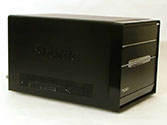 |
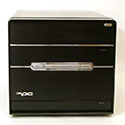 |
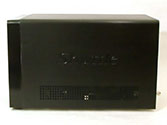 |
| Click on images to enlarge. | ||
As a size comparison, the G5 is 1 cm less in length than most other SFFs - not a big deal, but it's still a difference. The P series Shuttle chassis is 1 cm longer and wider, as well as 3.5 cm taller. There are reasons for the increased size, which you'll see in the features section in a moment. The ST20G5 is a very similar design, with the major difference being the chipset and features. It also comes in silver rather than black by default, which some people will prefer. Overall, though, we think that the G5 design is perfect for a variety of uses, including an office setting.
Features
|
Shuttle XPC SN95G5v2
|
||
| Dimensions | (w)200 mm x (h)185 mm x (d)310 mm | |
| CPU Support | AMD Socket 939 up to FX-55
|
|
| Memory Support | PC1600/PC2100/PC2700/PC3200 up to 2GB; 2 DIMM slots | |
| Motherboard | FN95 (proprietary) NVIDIA nForce3 Ultra Chipset 1X-5X (200-1000MHz) HyperTransport 8-bit/8-bit to 16-bit/16-bit HT Width |
|
| Expansion Slots | 1 x 4X/8X AGP; 1 x PCI | |
| Power Supply | 240W Silent X Power Supply 2 x 4-pin Molex; 1 x 4-pin FDD; 3 x SATA 1 x 4-pin ATX12V; 1 x 20-pin ATX |
|
| Internal Connections | 2 x SATA; 1 x IDE; 1 x FDD; 1 x LPT | |
| Audio | Realtek ALC655 5.1 channel | |
| LAN | 1 x 10/100/1000 Mbps (NVIDIA + PHY) | |
| Drive Bays | 1 x 3.5 External (FDD/HDD) 1 x 3.5 Internal (HDD) 1 x 5.25 External (CD/DVD) |
|
| Front I/O | 2 x USB 2.0 1 x IEEE1394 (4pin) MIC, Head-phone Power & Reset buttons Power on & HDD LED indicators |
|
| Rear I/O | 2 x USB 2.0 1 x IEEE1394 (6pin) PS/2 KB, PS/2 Mouse Serial port RJ-45 LAN Port (10/100/1000Mbps) Line-in, S/PDIF In Optical S/PDIF Out Coax Center/Sub, L/R Front, L/R Rear |
|
| Overclocking | CPU 200-280; CPU Ratio 4X-Max; Northbridge 1.60V-1.70V Vcc 0.800-1.700V; DDR Auto, 2.70-2.90V |
|
| Extras | ICE cooling | |
| Full Image Set | Shuttle SN95G5v2 Pictures (3.4MB) | |
| Manufacturer Link | Shuttle XPC SN95G5 | |
The feature list of the SN95G5 covers all of the requisite areas. Firewire, USB, GbE, and audio ports are all available. S/PDIF optical in and out ports are also included on the rear, along with an S/PDIF coaxial out connection. The remainder is pretty standard for a well-equipped SFF. There are two DIMM slots, an AGP and PCI slot, two SATA and IDE connections, and a floppy connection. The chassis has room for one internal 3.5" HDD, along with external 3.5" and 5.25" drive bays. The 3.5" external bay is unoccupied, so you can choose to either leave it empty or fill it with a floppy, flash card reader, or a second hard drive. That's pretty much it as far as expansion features, which isn't too surprising given the size of the case.
There are a few items worthy of further discussion, however. First is the choice of platform. While PCI Express is getting all of the news coverage these days, AGP is not dead yet. For those who spent several hundred dollars on a (formerly) high-end AGP graphics card, AGP is still perfectly acceptable. Going forward, PCIe cards will come out first, with bridge chips being used to allow backwards compatibility with AGP. (The 6600GT and X800XL are both prime examples of what we imagine will be the future trend in graphics card releases.) If you're building a new PC from scratch, AGP probably isn't the best choice; for those looking to assemble computers out of spare parts with a few new purchases, AGP still has a lot of untapped performance. The PCI slot is at present even more useful, as we have yet to see any PCIe X1 expansion cards. That will change in the future, but for now, it is possible to get sound cards, TV tuners, or a variety of other cards that will run in a PCI slot, where an X1 PCIe slot would sit empty.
Moving on to the CPU socket, we've already mentioned that socket 939 is our present SFF platform of choice. The new dual-core Pentium D is a more attractive alternative than the old Prescott, but for the price, performance, and heat characteristics, we still recommend socket 939. Heat dissipation is a much bigger concern in a SFF case, after all. What's nice about socket 939 is that it isn't a dead end, as a BIOS update should provide support for the (now shipping) dual-core Athlon 64 X2 processors. We have heard that a BIOS update enabling X2 support is available for the SN95G5, but we've also heard that Winchester and Venice cores require the SN95G5v3 (we're testing the SN95G5v2). If you can only get X2 and 90nm chip support with the v3 model, there are going to be some disappointed people. Shuttle in North America appears to be willing to swap SN95G5v2 for v3 in North America, but you'll have to talk to them on your own. (If you have tried this, please email me the results - did they swap without difficulty? How much did it cost? I'll include any details that I can get in the follow-up article.)
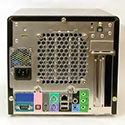 |
 |
| Click on images to enlarge. | |
There are a few minor concerns with the SN95G5, as usual. One is the rear audio ports: they're all green and the icons/text are difficult to read for those with less than stellar eyesight. Almost every motherboard/SFF that we've seen in recent years has color-coded the audio ports, and we're a little baffled that Shuttle didn't do this on their G5 models. The good news is that in contrast to several other units, we didn't encounter any issues with the onboard audio on the SN95G5. The rear ports were as clean as any that we've tested, and we didn't notice any noise on the front headphone port either. There may have been a very small amount of noise on the front port, but if so, it wasn't enough to be distracting. We do wish that the integrated audio were of the HD variety, but as we'll discover with the ST20G5, HD audio doesn't necessarily mean that it's good HD audio.
Another possible cause for concern is the lack of a flash memory reader. (The new P series includes a flash reader, and the older G4 chassis came with one as well.) The Soltek and G5 SFFs are the only models without a reader in this roundup. We're not too worried about this omission, however, as those who really want such support can purchase a reader from Shuttle or elsewhere. Still, given the price of the Shuttle compared to competitors' offerings (around $280 these days), some people may not be as ambivalent as we are.
In fact, a lack of expansion possibilities is the biggest drawback that can be levied against the SN95G5. One HDD, one optical drive, and one 3.5" external bay makes it one of the most limited SFF designs around. The 240W power supply is also rather small, although it handled our SFF configuration without incident. We're saying this not as a problem with the G5, but as something to be aware of should you purchase such a case - many other SFFs have this same set of expansion options. A design decision was made, and expansion was limited in favor of being smaller. The only way to further reduce the size would be to use 1.8"/2.5" laptop HDDs and a half-height optical drive. We might see such a design in the future, but laptop drives are quite a bit slower, so it's not a change that could be made without consequences. Those who are more concerned with expansion possibilities can turn towards the SN25P, as it is pretty much on the other end of the expansion spectrum for SFFs.


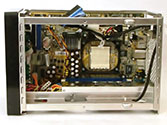








29 Comments
View All Comments
JarredWalton - Thursday, October 27, 2005 - link
Hopefully, anyone interested in the "promised" part 2 will find this post. I'm thinking of forgetting part 2 - I just have too much stuff to do! I've run some X2 benches/tests and can tell you this.The 330P, EQ3901-300P, SN25P, and ST20G5 all worked flawlessly with dual core - once the BIOS was updated. That last part is important, so let me elaborate.
For the 330P and ST20G5, the system WOULD NOT work with the BIOS I had (i.e. POST failed or complete system instability in the case of the 330P), so I had to switch back to a single core, update the BIOS, and then it worked. The 330P at first seemed to work, but I got frequent crashes and I couldn't even flash the BIOS with the X2 installed. If you have an extra 939 CPU, you should be fine; if you don't... well, I don't know if current 330Ps or ST20G5s are shipping with the latest BIOS or not, but I doubt it. (Ask Biostar/Shuttle for more information, I would suggest.)
Notably absent from the above list of X2 supported SFFs is the SN95G5v1/v2. I have v2, and it won't get past POST with an X2 processor. V3 will apparently work, but why buy an older AGP SFF these days? The Soltek worked fine, the SN25P was probably the best fit for the X2 plus a faster GPU, but the 330P was a lot more stable with the latest BIOS update. (The BIOS seemed to address several of the stability issues I had initially.) As far as I can tell, the USB + X2 issues of the SN25P have been resolved - I couldn't get any problems to occur, but then I may not be using the "right" USB device to cause a crash.
My pick overall remains with the SN25P. I successfully overclocked an X2 3800+ to 2.70 GHz in that system, where I could only reach 2.50 GHz in the 330P and 3901. Temperatures were a little lower than the 330P, cooling is better, but the system is larger. I'd say the 330P is now second overall in the recommendation list, and it does look pretty nice. The AGP units are not worth purchasing unless you can get them really cheap.
As nice as I think the ST20G5 looks, I feel the chipset used is complete garbage. Later ATI Xpress 200 chipsets (like the Crossfire stuff) are apparently much better, but the early Xpress 200 is at best equal to the like of ALi/ULi and SiS. Even VIA would be better (outside of integrated graphics performance) than the original Xpress 200. Overclocking remains essentially non-existent, and the smaller PSU (240W) will struggle with an X2 plus faster GPU. There's no way I would recommend spending $350 on the ST20G5.
Jarred Walton
SFF and Guide Editor
AnandTech.com
P.S. I'm skipping the 775 roundup as well, and will be moving on to later 775 systems for review. Basically, all of the 915/925 SFFs are outdated by the Pentium D, so there's no reason to purchase one (in my opinion). If you really want some brief thoughts on a specific 775 SFF, email me and I'll let you know. I have looked at several of the units, but putting together a 25000 word article on outdated hardware doesn't seem like a good use of time.
highlandsun - Tuesday, November 1, 2005 - link
Thanks for following up here, I just found this roundup while googling for ST20G5 reviews. My brother has an SN95G5v2 and we spent several hours one night trying to make it behave after updating to the latest BIOS. After the update Windows no longer saw his Logitech wireless trackball (but Linux still saw it just fine) plugged into the PS/2 port. We had to go back to the original BIOS that the thing shipped with. Unfortunately the original version doesn't support Cool'n'Quiet on the Winchester or Venice 3000+ that we plugged in (we had one of each), which was why we went looking for the BIOS upgrade in the first place.Anyway, he's using the SN95 for an HTPC, and I got interested in going the same route. But I was looking at the ST20 instead. The SN25P isn't a viable option because we're using Fusion HDTV tuner cards, and they're PCI only, no PCI-E version yet. I couldn't care less about AGP vs PCI-E for video in this case, as it's all overkill for simple media streaming. (The only key feature is making sure the video card supports DxVA for DVICO's MPEG decoder to work well.) But now it seems that none of Shuttle's current offerings are really suitable, since the ST20 really is too flawed in other areas.
Has anyone ever gotten an answer from Shuttle about why they would go to the trouble of using the Nforce3 Ultra but not using its integrated Gbit LAN??
dlevens - Sunday, September 4, 2005 - link
It would be nice to see a section on customer support. I have been extremely disapointed in Shuttle support for these SFF systems. I started with the SV25 and about 10 cubes later I am running the sn25p. I have to say I hate this thing. Also surprised to see there was no mention of some major issues with stability due to cheap or faulty sata cables. There are a ton of posts on sudhian about issues related to the sata cables. Curious if Anandtech saw any of these issues? http://forums.sudhian.com/messageview.aspx?catid=4...">http://forums.sudhian.com/messageview.a...amp;thre...Although, I would expect shuttle would send a well tested machine for a review site.
I also had a miserable time finding the most stable way to build the sn25p as far as drivers. Still not sure I have it right. This would be a great section to add in a review. I made a post here reguarding driver issues.
http://forums.sudhian.com/messageview.aspx?catid=4...">http://forums.sudhian.com/messageview.a...amp;thre...
One of my biggest complaints about the sn25p is sound. Was shocked to see the Via envy praised so much in the review. Maybe this is part of the driver issues I am having or could be the game I am currently playing, but sound is breaking up constantly on this thing. I have tried both drivers from VIA and both from shuttle. Anyone else playing Warlords IV on an sn25p and able to get your sound to work? I play warlords IV and run skype in the background for voice. Sound is garbled and breaks up.
Still looking for shuttle to be unseated in the sff market, would be nice to find some quality and stability to match the high price we pay for these sff systems. And a company who stands behind their product with great support would be icing on that cake.
Dennis
JarredWalton - Thursday, October 27, 2005 - link
Hey Dennis - I don't know if you'll see this, but I'll add it for others that might look. I obviously can't play all the games out there with each unit, so all I know is that the SN25P and the Via Envy did great on the tests I ran. The sound was also completely free of static, which is not the case for several of the others. The lack of static was far more important to me than other aspects of the sound system.Anyway, I didn't run into driver issues or SATA issues. I don't know if I just got lucky or what. I did a clean install of XP SP2, then I used the included CD to get sound and networking. I then downloaded the latest nF4 chipset drivers, along with graphics drivers for the ATI card I used, and I grabbed all the updates from Windows Update. Everything seemed to run fine.
artifex - Monday, August 22, 2005 - link
I think it'd be fun to compare these to Iwill's ZMAXdp, which is a dual-Opteron SFF. Not dual core, but dual processor. SFFTech says it's using nForce3 Pro as the chipset. It's also amazingly expensive, and has a silly little fin antenna :)JarredWalton - Thursday, August 25, 2005 - link
Iwill declined to send the current ZMAXdp when I emailed them, but they're working on an updated version for the future, so we'll see.Zak - Monday, August 15, 2005 - link
Frankly, each one of them has one single fault, just one, that makes, otherwise perfect box, useless for me... Some have the card readers up front that spoil the looks and I don't need them, some have no SPDIF out, some have 4 pin FireWire connectors, some are butt-ugly, some have on-board video. They'd be perfect otherwise if not for those single small problems. I haven't found a small factor case yet that would be perfect for me. So I'm sticking to towers for now.Zak
jopa25 - Saturday, August 13, 2005 - link
Hi, congratulations and thanks for that great review, in the first placeI'd have a little question about the the measurement of the noise levels of these SFF, is there any differences in the way noise was measured in relation with the former roundup (478/754 SFF roundup) ?
I expected the newer models to be quieter without GPU fan than the 478/754 SFF. However, according to the measurements, at 12 inches far, 4 out of the 5 478/754 SFF reviewed remained below 30dB, while the new models keep in a range from 37 to 46 dB in the same test. Quite a significant difference, isn't it?
As a part of an explanation, I guess the processor used in the last roundup (AMD Athlon 64 3800+ with Newcastle core) is not exactly wonderful at power saving, but should not be far from the Intel Pentium 4 3.0 used in the other roundup anyway.
So, the question is: Is there any reasonable explanation for these high levels of noise with fanless GPU, in comparison with those from the 478/754 roundup?
JarredWalton - Saturday, August 13, 2005 - link
I'm not entirely sure why the noise levels were higher. Part of it may be due to the time of year (winter vs. summer). The room that the systems were in was probably closer to 65 F for the last roundup, whereas I'd say close to 75 F for the current roundup. A 10 degree difference in room temperature would have a substantial impact, unfortunately. (If you compare the SN25P results to the March testing, it was substantially louder during stress testing.)I may not have measured in the exact same location relative to the last SFF roundup. I think I measured the socket 478 units from the front, which may have impacted things, and I moved some desks around which could have impacted scores as well. The rear of the SFFs are now closer to a wall than the old location, so noise reflecting off the wall might be changing the readings a bit.
I tried to be consistent with all the units in the roundup, but the use of differing CPUs makes it hard to say how they compare with the older models. I would say, however, that in typical use only the G5 units were at the same level as the last roundup. The 330P idled very low, but stress tests made it quite a bit louder. The SN25P and EQ3901 are both clearly louder than everything but the e-bot, which is roughly on the same level in terms of noise.
WooDaddy - Friday, August 12, 2005 - link
Jarod,GREAT Article. For quite some time I wanted to see a review with the SN25 and ST20 together. In the meantime, I bought a Mac Mini (quit screaming "traitor"). Out of curiousity, do you or anyone know the rated noise levels of the mini? It's dead quiet even at full CPU.
For you LGA775 SFF round-up, please don't forget to consider the Trigem Kloss PC (www.klosspc.com available at ZZF). Personally, it's the best looking SFF I've seen (better than the ASUS Spressos). I've been desperately looking for a review on that badboy.
Thanks